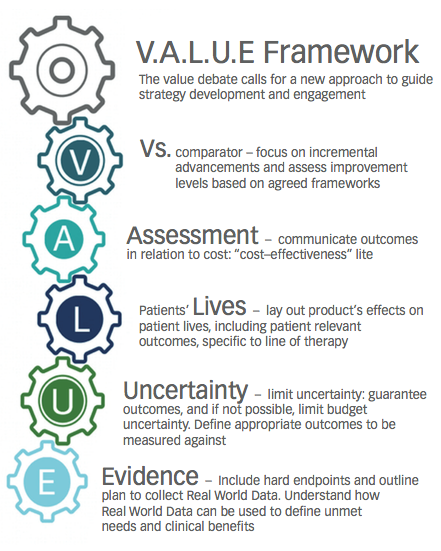Defining Value: The Payer Perspective
Pharmaceutical Executive
How a broader “value” understanding can benefit brand teams.
The drug value debate in the US has taken up roots and is here to stay. It has moved from newspaper headlines and 60 Minutes TV exposés to physician associations and clinical groups; from oncology and orphan drugs to cardiology and primary care; from being focused solely on drugs that provide marginal improvements to products that can fundamentally change treatment paradigms. And while much of the focus of the debate has been on how stakeholders make decisions based on value, how we define value is a complex and unresolved debate in itself.
Payers, physicians, patients, and pharmaceutical companies each use a different lexicon when defining and discussing value. Each stakeholder group also comes to the table with perceptions on how the other groups are defining value. As stakeholders engage to assign value to therapies, these gaps become glaringly obvious and make it clear that while we are all talking about the same thing, we are not always speaking the same language.
We will never move to one definition of value, and it is unlikely that we want to. But can we do a better job of understanding other stakeholders’ definitions to prepare us for smoother engagements? And particularly in the US, where there are no officially sanctioned assessments of “value” for pharmaceuticals, and where the debate is moving more and more quickly as healthcare costs escalate, can we use a broader understanding of stakeholders’ definitions to support new commercial engagement approaches? The answer is Yes.
Defining value
To understand the US payer perspective, IMS Consulting Group conducted an online survey of more than 30 managed care organizations and pharmacy benefit managers (PBMs). To compare these results with nations that have experienced the value debate for much longer and do conduct value assessments, we carried out similar qualitative discussions with pay ers from France, Germany, Spain, Italy, and the UK.
What did we learn?
Nearly 75% of US payers defined value as the ratio of benefits to costs-admittedly, a “cost-effectiveness-lite” approach. All European Union (EU) payers also chose this same definition, even though not all formal access review processes include this approach (see chart).

When probed on what drove this definition, payers generally defined benefits as relative to standard of care, rather than in absolute terms. The top three benefits ranked as follows:
Clear winner: Improvement in efficacy versus standard of care.
- Tied for 2nd place: Reductions in mortality and safety improvements versus standard of care.
- Close 3rd place: Level of satisfaction with existing treatments.
When asked to expand on costs, payers noted that the focus is on the price of therapy, rather than cost-offsets or resource utilization, and that costs are generally considered per treatment course or on a yearly basis.
What challenges does this raise?
This definition raises some key challenges for the other stakeholders in healthcare. It does not place weight on patient experience, nor does it incorporate clinical realities for manufacturers around the time horizon for “benefits” and the opportunities that a new pathway or mechanism of action may provide. Other challenges include:
- NOT SUSTAINABLE - Do the math. The quickest way to increase “value” in the ratio-based definition is to decrease cost. We’ve seen this approach play out with the proliferation of closed formularies and increasing levels of contracting, but is this sustainable?
- NOT ACHIEVABLE - A set numerator. The other, more challenging approach to increasing value is to show greater benefit. If only things were that simple, but we know they are not, particularly if all internal stakeholders have not engaged cross-functionally early in the market-access process, before clinical trials are set.
- NOT EXECUTABLE - A mindset shift. This definition suggests a more “cost-effectiveness”-driven approach than has been historically employed in the US. However, FDA regulations on what and how data can be shared is a real factor that has to be considered before any changes in approach can be implemented.
Communication barriers
We also asked US payers what do they view as the manufacturer definition of value. Only 14% of payers noted that manufacturers define value benefit/cost. Therefore, 60% of payers in the sample were convinced that manufacturers have a different definition of value-but is perception reality? The answer is No. Discussions with biopharma manufacturers show that there is a broad range in definitions of value, but, broadly, most manufacturers define value in the same way as payers: benefits/costs. So could we be saying the thing, but not speaking the same language?
A different approach: A V.A.L.U.E framework
How do we move forward to engage in discussions about value, when we are approaching the conversation from a different viewpoint? And how should these factors be incorporated into a company’s strategy? The answer is to proactively leverage the V.A.L.U.E framework (see chart) into

discussions and strategy planning to address differences in value definitions.
The V.A.L.U.E. approach requires rethinking stakeholder engagement. To effectively employ this approach, manufacturers need to be fluid in considering when and how to engage payers. Proactively defining value and the factors that should be incorporated is critical to successfully align on the value of a new product in the future. Elements of the V.A.L.U.E approach:
Recognizes that payers incorporate money/cost when they determine “value.”
- Across markets, payers are defining product value as incremental benefits in relation to cost of product.
- Turn the process on its head: Develop a payer, physician, and patient value story pre-Phase III.
- Assess product benefits in relation to costs early in the development cycle.
- Always include clinical development and commercial teams in early-stage discussions.
Momentum is obvious
The evolution of the value debate is showing up everywhere. Payers have been proactively engaging with pharmaceutical market stakeholders around their definition of value. In August 2015, CVS Health Research Institute published a piece in the Journal of the American Medical Association (JAMA), encouraging the cardiology community to review and reconsider current treatment guidelines for the management of high cholesterol given the launch of PCSK9 inhibitors, using terms such as “cost-effective use” and “referencing changing market dynamics.”
We liken the value definition conversation to arguments we had on Twitter this year around #thedress. The “#thedress” was an optical illusion posted online-a picture taken in a certain way that made a dress look white and gold to some and blue and black to others. There are biological and visual factors that drove this difference-but the difference was real and sparked nationwide debate. Two people looking at the same picture saw two completely different color schemes. There were two types of discussions that ensued:
- The impassioned debate: Each person tried to convince the other that they were “right” and what the “right” colors were, while both sides were incredulous that someone could see a different color.
OR
- The nuanced argument: One person explained the difference by showing how framing, lighting, and photographic differences changed the colors. The dress actually was black and blue.
Which conversation would you want to have?
Susan Abedi is a Senior Principal in IMS Consulting Group’s New York office. She can be reached at sabedi@imscg.com

Trump: 'Major Tariff' on Pharmaceuticals Coming Soon
Published: April 9th 2025 | Updated: April 9th 2025“We’re going to tariff our pharmaceuticals, and once we do that, they are going to come rushing back into our country," President Donald J. Trump said during a Tuesday night dinner in Washington.
ROI and Rare Disease: Retooling the ‘Gene’ Value Machine
November 14th 2024Framework proposes three strategies designed to address the unique challenges of personalized and genetic therapies for rare diseases—and increase the probability of economic success for a new wave of potential curative treatments for these conditions.